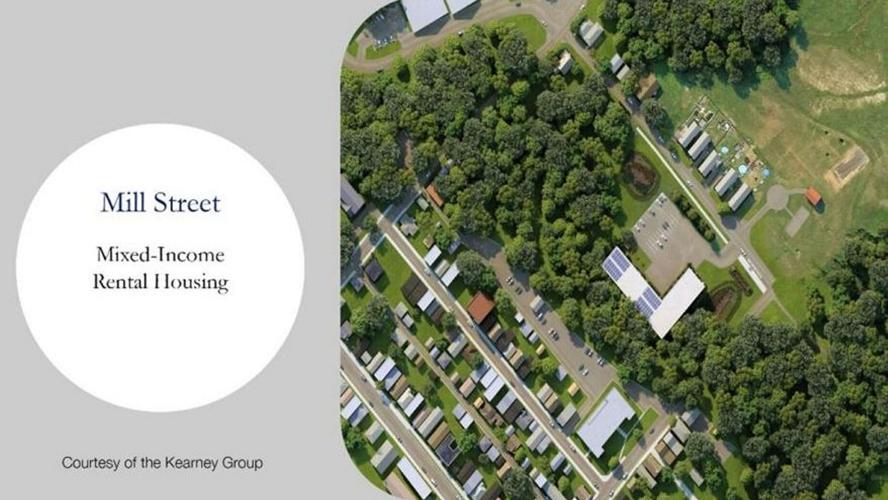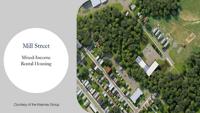HUDSON — City officials and Hudson City School District leaders are at odds over the future of a land parcel on Mill Street.
The property in question is the vacant land on Mill Street across from Charles Williams Park. The proposal calls for a 60-unit apartment complex on Mill Street.
According to a statement by the board of education released Monday, “Land records showed that the city of Hudson owns the land, which was given to the city by the school district in 1983. That transaction included a restriction that the land be used for ‘park and recreational purposes only’ — and that any other use would return ownership of the property to the school district. The land, while not an official park, has been used by the community for informal recreation.
“The board has told the city administration that it would welcome an official outline of the city’s plans for the land, as well as an official request to remove or change the ‘park and recreational purposes only’ restriction. To date, however, the city has not provided an outline or issued that official request.”
The school district said these details are necessary so the board can determine the next legal steps for the property to be considered for other uses.
“The board of education cannot simply OK a city request, and the board and/or the city cannot simply withdraw or ignore the ‘park and recreational purposes’ clause. That restriction in the 1983 deed must be legally addressed before a housing plan can move forward.”
Furthermore, the board noted that the New York State constitution prohibits public entities from giving gifts unless there is a public benefit. In addition, the city is planning on selling the property to the Kearney Realty & Development Group, which would construct the housing.
“Such a sale to a developer does not qualify as a public benefit, so the land must be sold for a fair market price,” the board said. “Other issues that would require attention: The land is in a flood zone, meaning that there is a high risk of flooding during heavy rain. What costs would the school district potentially have if families move into the additional housing and increase enrollment in our schools?”
Through a media release, Mayor Kamal Johnson’s office responded Monday to the school board’s claims.
“The city first received official communication from the board of education regarding the Mill Street deed restriction in a letter received Wednesday, Sept. 20, 2023, detailing the district’s requirements to review the matter,” according to the release. “The mayor’s office will be pleased to comply and provide both an official outline of the city’s plans for the land and an official request to remove or change the Mill Street property’s deed restriction to the board of education; however, it must be noted that by publicly announcing that the city ‘has not provided an outline or issued that official request less than a week following the city’s receipt of such a request, the district appears to be misleading the public to believe that the city has not been actively and repeatedly attempting to discern these very instructions from the BOE over a number of months.”
In City Hall’s response, the statement took the school district to task over the district’s argument that a sale to a developer does not qualify as a public benefit.
“This particular sale is for the purpose of developing affordable housing, which existing case law successfully argues can be considered a public benefit,” the mayor’s office said. “The housing project at Mill Street plans to have rental prices set at affordable rates ranging from 30% to 110% of the area median income. The district notes that the land’s placement in a flood zone is a matter of concern. The Development Team is aware of the existing floodplain on the Mill Street parcel, as well as the impact flooding has on the surrounding neighborhood. One of the reasons the city selected this developer is because they have successfully redeveloped sites located in 100-year and 500-year floodplains.”
The mayor’s office also addressed concerns about enrollment.
“The district’s statement poses the question of the budgetary impact of increased enrollment due to the additional housing created by this project,” according to the statement. “Hudson City School District enrollment has decreased over 10% between 2017 and 2021, and 33% since 1997. This pattern of decreased enrollment is increasingly common in rural parts of the Hudson Valley due to the trend of fewer births and outmigration due to the rising cost of living. The district lost funding in recent years because local demographics have changed. The city of Hudson hopes to prevent further drops in enrollment by providing housing for families.”
At the Sept. 12 board of education meeting, Johnson expressed the city’s immediate need for housing.
“I don’t have to remind the school district about the city’s problems with housing at the moment,” Johnson said. “Housing is an immediate need; it’s the reason we can’t find any teachers, especially those of color, and the reason we can’t fill positions in all our services, including our hospitals.”











